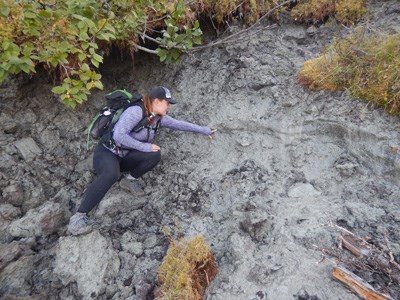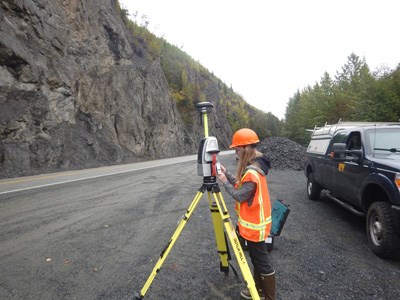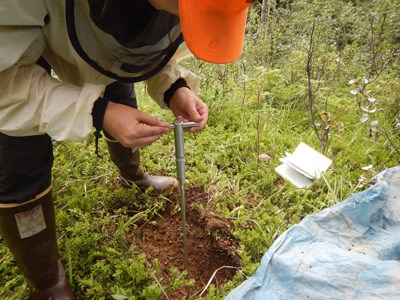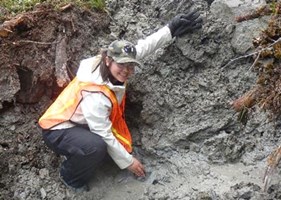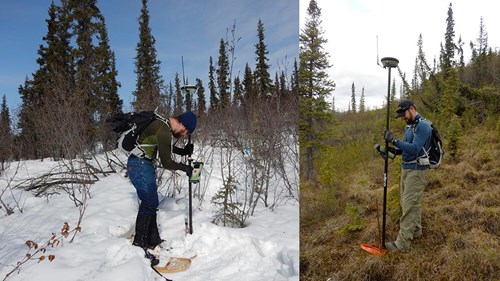Selected Publications
Link to Scholar Citation Page
- Miandad, J., Darrow, M. M., Hendricks, M. D., Daanen, R. P. (2020). “Landslide mapping using multiscale LiDAR digital elevation models.” Environmental & Engineering Geoscience: 26(3), 1-21.
- Darrow, M. M. and Lieblappen, R. M. (2020). “Visualizing cation treatment effects on frozen clay soils through µCT scanning.” Cold Regions Science and Technology: 175.
- Darrow, M. M., Guo, R., Trainor, T. P. (2020). “Zeta potential of cation-treated soils and its implication on unfrozen water mobility.” Cold Regions Science and Technology: 173.
- Gong, W., Darrow, M. M., Meyer, F. J., Daanen, R. P. (2019). “Reconstructing movement history of frozen debris lobes in northern Alaska using satellite radar interferometry.” Remote Sensing of Environment: 221, 722-740.
- Kruse, A. M., Darrow, M. M., Akagawa, S. (2018). “Improvements in measuring unfrozen water in frozen soils using pulse nuclear magnetic resonance (P-NMR) method.” Journal of Cold Regions Engineering: 32(1), 7 p., doi:0.1061/(ASCE)CR.1943-5495.0000141
- Darrow, M. M., Daanen, R. P., Gong, W. (2017). “Predicting movement using internal deformation dynamics of a landslide in permafrost.” Cold Regions Science and Technology: 143, 93-104, https://doi.org/10.1016/j.coldregions.2017.09.002
- Kruse, A. M. and Darrow, M. M. (2017). “Adsorbed cation effects on unfrozen water in fine-grained frozen soil measured using pulsed nuclear magnetic resonance.” Cold Regions Science and Technology: 142, 42-54.
- Darrow, M. M., Gyswyt, N. L., Simpson, J. M., Daanen, R. P., Hubbard, T. D. (2016). “Frozen debris lobe morphology and movement: an overview of eight dynamic features, southern Brooks Range, Alaska.” The Cryosphere, 10, 977-993, doi:10.5194/tc-10-977-2016.
- Darrow, M. M., and Jensen, D. D. (2016). “Modeling the performance of an air convection embankment (ACE) with thermal berm over ice-rich permafrost, Lost Chicken Creek, Alaska.” Cold Regions Science and Technology, 130, 43-58.
- Simpson, J. M., Darrow, M. M., Huang, S. L., Daanen, R. P., Hubbard, T. D. (2016). “Investigating movement and characteristics of a frozen debris lobe, South-Central Brooks Range, Alaska.” Environmental and Engineering Geoscience, 22(3), 259-277.
- Darrow, M. M., and Jensen, D. D. (2014). “Cold region applications for in-place inclinometers based on microelectromechanical systems technology.” Transportation Research Record, 2433, 1-9.
- Darrow, M. M. (2013). “Automated MEMS-based in-place inclinometers.” Geotechnical News, 31(3), 27-30.
- Obermiller, K. E., Darrow, M. M., Huang, S. L., Chen, G. (2013). “Site investigation and slope stability analysis of the Chitina Dump Slide (CDS), Alaska.” Environmental and Engineering Geoscience, 19(1), 27-40.
- Daanen, R. P., Grosse, G., Darrow, M. M., Hamilton, T. D., Jones, B. M. (2012). “Rapid movement of frozen debris-lobes: implications for permafrost degradation and slope instability in the south-central Brooks Range, Alaska.” Natural Hazards and Earth System Sciences, 12, 1521-1537.
- Darrow, M. M., Bray, M. T., Huang, S. L. (2012). “Analysis of a deep-seated landslide in permafrost, Richardson Highway, South-Central Alaska.” Environmental and Engineering Geoscience, 18(3), 261-280.
- Darrow, M. M. (2011). “Thermal modeling of roadway embankments over permafrost.” Cold Regions Science and Technology, 65, 474-487.
- Darrow, M. M., Huang, S. L., Akagawa, S. (2009). “Adsorbed cation effects on the frost susceptibility of natural soils.” Cold Regions Science and Technology, 55, 263-277.
- Darrow, M. M., Huang, S. L., Shur, Y., Akagawa, S. (2008). “Improvements in frost heave laboratory testing of fine-grained soils.” Journal of Cold Regions Engineering, 22(3), 65-78.
Doctor of Philosophy, Engineering: Arctic Engineering
May 2007
University of Alaska Fairbanks
Bachelor of Science Degree, Geological Engineering
December 2002
University of Alaska Fairbanks
Teachers for Alaska Certification Program, Math/Science
May 1997
University of Alaska Fairbanks
Master of Science Degree, Geology
December 1995
University of Alaska Fairbanks
Bachelor of Science Degree, Geology
August 1993 University of Washington
Appointments
Department Chair, Civil, Geological and Environmental Engineering 2020 – present
Professor, 2018 - present
Department Chair, Mining and Geological Engineering 2015-2019
Associate Professor, 2013 - 2018
Assistant Professor, 2008 - 2013
Department of Mining and Geological Engineering, University of Alaska Fairbanks
Geotechnical Engineering Assistant, 2005 - 2008
Graduate Intern, 2002 - 2005
Alaska Department of Transportation and Public Facilities, Fairbanks, Alaska
Teaching Experience
Teaching Assistant, 2002
Department of Mining and Geological Engineering, University of Alaska Fairbanks
Earth and Space Science Instructor, 1995, 1996, 1997, 1998, 2000
Upward Bound Math/Science, Fairbanks, Alaska
Secondary Teacher, 1997 - 1999
Minchumina Community School, Iditarod Area School District, Lake Minchumina, Alaska
Graduate Teaching Assistant, 1993 - 1995
Department of Geology and Geophysics, University of Alaska Fairbanks
Courses Taught
- GE101 – Introduction to Geological Engineering
- GE 261 - General Geology for Engineers
- GE 365 - Geological Materials Engineering
- GE 375 - Principles of Engineering Geology and Terrain Analysis
- GE 376 - GIS Applications in Geological and Environmental Engineering
- GE 381/382 - Field Methods and Applied Design I and II
- GE 430 - Geomechanical Instrumentation
- GE440 – Slope Stability
- GE441 – Geohazard Analysis
- GE480 – Senior Design
- GE626 – Thermal Geotechnics
- GE 692 - Graduate Seminar
- ES 208 – Mechanics
- ES 209 - Statics


